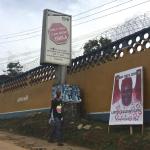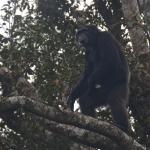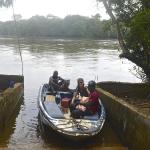© 2011 Sabrina Swenson. All Rights Reserved.
Sierra Leone
November, 2017
Civil war, corruption, Ebola, mud slides, extreme poverty, pollution, not even safe drinking water; why would anyone go? Sierra Leone is more than just its tragic past and current circumstances. It’s a country of unbelievably kind and happy people, trying to make things better, not to mention home to some beautiful beaches.
This tiny, English-speaking country sits in West Africa surrounded by its neighbours Guinea and Liberia with the Atlantic Ocean to its west. It's one of the poorest countries in the world. About 75% of the country are Muslim with most of the remaining Christian. The Atlantic slave trade had a great impact in Sierra Leone, as the trade flourished in the 17th and 18th centuries. It later became the centre of the anti-slavery effort when the trade was abolished in 1807. Soon after, Sierra Leone became a British colony. They only gained independence from Britain in 1961.
Sierra Leone had a brutal civil war that began in 1991. Over 120,000 people were killed and two million displaced during the time which was marked by the use of enslaved child soldiers and widespread use of amputation as a weapon of terror. The war finally ended over ten years later, in 2002 with the help of Britain and a large UN peacekeeping mission. Although it's experienced recent growth in its economy, the effects of the civil war continue to be felt today. Rich in minerals, especially diamonds, the trade of illicit gems, known as "blood diamonds" funded conflicts and perpetuated the civil war. The government has sought to crack down on the trade. Agriculture is a significant part of the economy. Rice is the most important staple crop. Interestingly, a man can have many wives in Sierra Leone, as long as he can afford them!
My trip began with a flight into the capital, Freetown. The most unusual fact about arriving in this capital is that you immediately need to board a boat once off the plane. Lungi International Airport is across an estuary from the capital and can be reached by a 40 minute ferry ride. The alternative being a three hour drive, with the possibility of far longer, due to Freetown's notorious traffic jams. The ferry is definitely the way to go. I arrived on the other side of the water and as it was the middle of the night, had arranged a ride to my hotel. They eventually showed up and after checking in, I went right to bed. I woke in the morning and headed to breakfast. The grounds of the sprawling hotel were vast and the restaurant was open air with only a thatched roof. I sat to have my coffee and kibble only to watch a deer saunter by. Several friendly and very tame deer made the grounds their home.
After breakfast, I exited the security gate of the hotel (standard in Freetown) and hailed a taxi to the center of the capital. This is when I realized why they told me it took so long to reach the center of Freetown. From the beach where my hotel was located, it didn't look very far on the map to the center. However, when mixed with the capitals lack of sufficient and appropriate roads, not to mention over a million residents, chaos and traffic jams ensued.
Once in the city center, I decided I should probably get more cash for the duration of my trip. I wandered the streets looking for an ATM, but only found individuals willing to exchange money right there on the street. One particularly enterprising guy had printed up business cards stating his expertise of "money changer". I chuckled, but admired his moxie and so we set about the business of settling on an exchange rate. When a what-I-thought-to-be fair rate was reached, he disappeared into the crowd to retrieve the (for them) rather large sum and just as quickly returned. We exchanged bills and with both parties now satisfied, he reminded me that he was always on this particular street, if I ever needed more money exchanging services. I spent the rest of the day wandering around the extremely busy, populous downtown area. I stopped at the National Railway Museum, where there was a collection of restored locomotives, including one commissioned for the Queen of England in 1961. I also saw the National Museum. While strolling the streets I saw many reminders of the not-long-ago Ebola epidemic. Every so often there were large signs pleading "Only you can stop Ebola" with instructions that only you can protect your family and community by calling a special number should you expect infection.
It wasn't long ago that the epidemic was running wild in the country for almost two years. Predictions have over 20,000 people lost their lives. It began in 2014 and wasn't eradicated until 2016. It's believed to have begun when a traditional healer returned from next-door Guinea after trying to cure someone who was sick. He didn't realize at the time that it was Ebola. The first victim in Sierra Leone, was the healer, then his family and it went on from there. In this region, the practice of kissing and touching the dead at funerals was sighted as helping to spread Ebola as a deceased person was still highly contagious. As the disease spread to other regions, eventually a "no touch" policy was declared as well as a curfew all in the hopes of curtailing the disease. Eventually, with the number of deaths rising, other countries started to send aid as well as personnel. Finally, almost two years after it began, The World Health Organization declared Sierra Leone Ebola-free. The warning signs around the country, however, still remain today.
After my first day spent checking out Freetown, I headed back to my hotel. I found a great restaurant on the beach next door and had some fantastic seafood, dirt cheap.
My second day I was once again greeted by the resident deer staring at me as I ate my breakfast. Shortly thereafter, my driver and guide arrived to pick me up. Since tourism is almost non-existent in Sierra Leone, local transportation to where I wanted to go in the country, was simply not an option. And so, I obtained a driver and guide. The roads also leave a lot to be desired, with only a small amount being paved. As such, a 4x4 vehicle is a must in Sierra Leone. Large, vehicle-sized potholes filled with water were commonplace.
Our first stop was Tacugama Chimpanzee Sanctuary. Its purpose, to take care of rescued chimps and educate humans about primates. We set off down Sierra Leone's bright-red dirt roads and eventually pulled into the sanctuary. It was beautiful. I walked into the reception hut and signed into my room for the night. Tacugama has the bonus of numerous tree houses that overlook the sanctuary that you can bunk down in for the night. Mine was a short walk through the thick jungle. A two level hut appeared. I walked in and it was adorable in a simple and rustic kind of way. It had running water and electricity, with a bedroom on the second level. I left my backpack and headed back to the main area. A guide finally appeared and he took me around the sanctuary talking about the chimps. The guide talked about how intelligent chimps are and I asked if any had escaped. Yes, he proclaimed! Years ago 30 chimps got loose and only 27 were ever recovered. After much walking around the foliage-filled area, I headed back to my hut to clean up. Dinner was to be served in the open area restaurant hut. I showed up at the appropriate time, but no one was there except a lone cat. I made use of the only electrical outlet to recharge my camera. Eventually a lady turned up with a feast for me alone and there was no way I could possibly eat the entire spread. I ate as much as I could and shared some with the cat, then retired for the evening. Night comes fast in the jungle. Before I knew it, I had to get out my headlamp to unlock the door. I took a quick shower and retired for the evening. Early the next morning my driver and guide were there to collect me and off we went, headed north toward the Outamba-Kilimi National Park.
After numerous hours of arduous roads, including one river crossing on a man-powered ferry, we finally arrived in the park. We continued until we reached a river. This is where we would bed for the night. Six ramshackle huts were there along with one "toilet" a short walk into the woods. I chose a hut and upon opening the ill-fitting door found only a bed with mosquito net and a plastic chair. I put my backpack on the chair and shut the lock-less door. A local came with kayaks so we could check out what was on the river. My driver and guide stayed behind chatting and said they'd have dinner ready upon my return. We set off down the river and saw a variety of birds. About an hour and a half in, my guide pointed at the not-far distance at a group of hippopotamuses. I had seen these large beasts before, but never from the water line! We stayed our distance and watched them. The dominate male kept darting back and forth, apparently protecting his territory and herd.
Hours later we arrived back at camp and the guide and driver had a fire roaring. Dinner was almost ready and I was famished. After eating a basic, but delicious meal, the guide and driver said they were going to the closest village. I didn't ask what for, but I'm guessing to socialize. They left me with a handheld lamp for my hut and set off. I started to unpack my bag and as the day ended it got darker and darker. As I was the only one there (not knowing exactly when the guide and driver would be back) I looked around at the ramshackle huts in the remote middle-of-nowhere place and thought how the scene was just like one out of a horror movie! The night finally came and with no major city around to light up the sky, it was now pitch black. I turned on my headlamp, but quickly changed to the handheld lamp as the bugs were headed straight for the light on my face. I sat alone in the dark where the only noise was the sound of the wind... and it wasn't windy. With no cell or internet service, I read a little, but the light was inadequate. About an hour and a half later, the guide and driver came back. We chatted a while and I eventually went to sleep.
Bright and early the next morning we were up and had breakfast over the campfire. Once we were packed, we were on our way across the country to Tiwai Island. Set on the Moa River, Tiwai Island is run as a conservation research project. There's more than 700 plant species, 11 species of primates and 135 bird species. After a full day of driving, although it wasn't the miles that slowed us, but rather the road condition, we finally arrived late in the day. We went to the riverside and boarded canoes to head to the island. Upon arriving in the thick jungle, we trekked into the centre of the island.
As soon as I arrived, I saw a group of five guy unpacking. They were hanging their gear and drying their kayaks. I found out they were Brits and one was a wounded warrior. In an effort to give wounded warriors a bit of camaraderie like they had in the military, they had raised money so his trip was completely paid for. The five had been kayaking the Moa River for almost a week, sleeping in hammocks. What a great adventure! In addition, there were a couple young NGO workers and a couple people who worked at the American Embassy, all on some time off exploring the country. The Brits shared their beer with us and we all sat at a long table chatting away. After dinner we called it a night. With no huts on this island, we were all in tents. I slept well, however, upon waking, discovered my legs were completely covered with chigger bites. Since the area we were in was wooded, the chiggers got me! After breakfast, I headed off with a couple others to do a walking tour of the island. We saw a variety of monkeys and birds. After that, I headed off for more kayaking. I finished the day and we headed back to our vehicle. Once off the island and back on the mainland, there were groups of kids from the nearby village, hanging out and playing. They were extremely friendly and I chatted with them while my guide and driver got ready to depart. On the long road back to the capital, we stopped numerous times at local villages to see what local life was like in the country. Every person I came in contact with was extremely friendly and happy.
Once we were on the outskirts of Freetown, my guide pointed to a large hill in the distance. Mount Sugar Loaf was in the news last August. In the middle of the night, after much heavy rain, part of the hill collapsed in a huge mudslide which drowned over 300 people. Deforestation was blamed for the landslide. We also passed large tents where residents of that area still live today waiting for new housing.
My last afternoon in the country was spent taking in the beautiful beaches outside Freetown. You'd never know you were in Sierra Leone looking at this stunning scenery.
Sierra Leone is trying to improve its circumstances. From the anti-teen pregnancy signs all around the country, to free primary school (except for books and uniforms), to getting a fine for driving without a seatbelt they're at least trying to improve their situation. And through it all, in spite of a horrid past and seriously trying times like most of us will never know, they remain unbelievably friendly, kind and hopefully for a better tomorrow. A lesson for us all.



